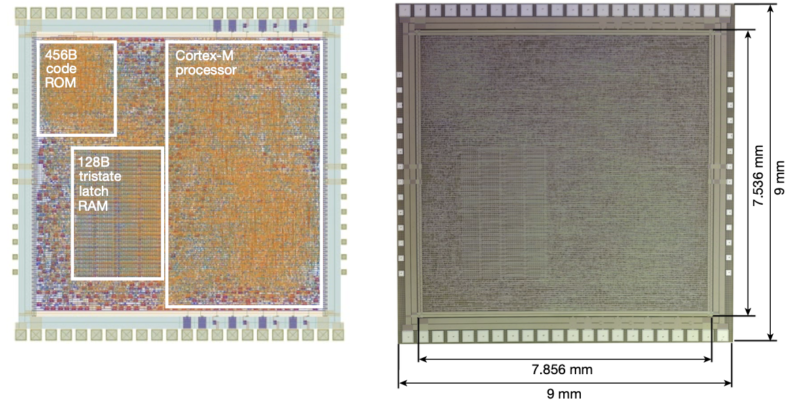
Wearable electronics, like watches and fitness trackers, represent the next logical step in computing. They've sparked an interest in the development of flexible electronics, which could expand the category to include products like clothing and backpacks.
Flexible electronics run into a problem, however: Our processing hardware is anything but flexible. Most efforts to deal with that limitation have involved splitting up processors into a collection of smaller units, linking them with flexible wiring, and then embedding all the components in a flexible polymer. To an extent, the process is a throwback to the early days of computing, when a floating-point unit might reside on a separate chip.
But a group within the semiconductor company Arm has now managed to implement one of the company's smaller embedded designs using flexible silicon. The design works and executes all the instructions you'd expect from it, but it also illustrates the compromises we have to make to produce truly flexible electronics.
Not quite CMOS
The basic idea behind flexible electronics is remarkably simple: start with a flexible substrate (like plastic or paper) and use it as a substrate for fabricating a thin layer of a flexible semiconductor. A variety of semiconductors fit the bill, ranging from atomically thin materials to semiconducting polymers. But most of the options aren't mature technologies with respect to their use in the fabrication of logic gates, so working with them involves two layers of experimentation—both with the materials themselves and with their flexibility.
Amorphous silicon is a somewhat familiar option. The silicon used in the manufacture of existing processors is crystalline, meaning it's in the form of an ordered array of atoms. Amorphous silicon isn't, and it's flexible as a result. Plus, we know how to work with amorphous silicon, since we use it for things like solar panels and LCDs. It's also inexpensive, partly because it can be processed into transistors through simpler techniques than needed for crystalline silicon.
The downside is that amorphous silicon comes up short in several measures, including performance, power efficiency, and circuit density. That said, many of the potential uses for flexible electronics don't require much in the way of performance.
PlasticArm
In keeping with the idea of minimal performance requirements, the team at Arm worked with PragmatIC Semiconductor to implement a version of Arm's Cortex M0+ processor termed "PlasticArm." The M0+ is a 32-bit processor that can execute a simplified subset of the Arm "thumb" instructions; it's optimized for small sizes and low power use, and it is generally used as an embedded processor.
Even by the standards of a very simplified processor, PlasticArm had some distinct features that set it apart. For one thing, the small bits of memory that processors use to store the data they're working on (called "registers") are normally located in the processor itself because it kills performance to go to external RAM in order to read this memory. To simplify the PlasticArm's processor, the CPU's registers are located in a reserve section of the RAM—and the system was made with only 128 bytes of RAM.
The system and applications that run on PlasticArm are held in a 456 byte ROM chip that is also separated from the processing hardware. Right now, the ROM can't be updated (it's read-only), but the team hopes to change that in the next iteration.
All the key pieces—the processor, the RAM, the ROM, and the interconnects—were made using amorphous silicon and fabricated on a flexible polymer. The system also has pins for off-chip communications.
Overall, the performance isn't good. Its maximum clock speed is a stately 29 kilohertz, and it consumes about 20 milliwatts at that speed. That may sound like very little, but an M0+ implemented on standard silicon only needs a bit over 10 microwatts to hit a megahertz. On the positive side, it has over 18,000 individual gates, which is over an order of magnitude higher than any previously described flexible processor. It also successfully executed all the software in its ROM, although the researchers only did tests without bothering to use the processor's distinctive feature—they never actually flexed it.
Next steps?
The team is already planning its next steps, which mainly involve reducing power consumption. That reduction is appropriate given the gap between the performance of the processor and that of standard silicon. The researchers also hope to get the gate count up to over 100,000, though they think the approach will end up maxing out somewhere below a million gates.
The paper describing the processor finishes by speculating about the potential of an "Internet of everything," where things like clothing and food packaging can have a flexible processor slapped on them. The paragraph is vague about what this expansion will get us, simply suggesting that it would "unravel innovations."
That said, plenty of researchers are working on embedding sensors and small power sources into things like clothing to monitor everything from activity to environmental exposures. Some of these uses will need a system to manage their behavior and data, and a flexible processor would fit the bill.
Nature, 2021. DOI: 10.1038/s41586-021-03625-w (About DOIs).



3175x175(CURRENT).thumb.jpg.b05acc060982b36f5891ba728e6d953c.jpg)

Recommended Comments
There are no comments to display.
Join the conversation
You can post now and register later. If you have an account, sign in now to post with your account.
Note: Your post will require moderator approval before it will be visible.